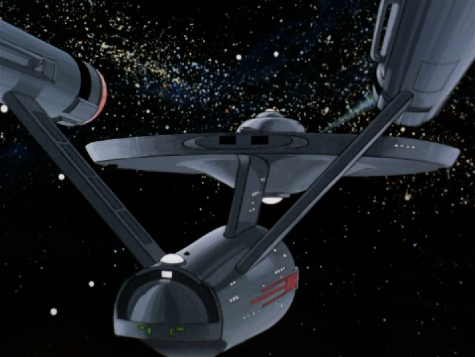It weighed on my heart to hear that Lou Scheimer, founder of Filmation Studios, had died this past October. Like a lot of Gen X’ers I grew up part of the Filmation Generation, in thrall to a studio whose output (along with that of Hanna-Barbera) shaped the landscape of my every Saturday morning: Fat Albert, The Adventures of Batman, The New Adventures of Flash Gordon, and yeah, even He-Man, were all required viewing for me.
But as a dyed in the wool Star Trek fan from almost the moment of conception onwards, number one among these was Star Trek: The Animated Series (or “TAS”), which ran for 22 episodes from 1973 to 1974, after the cancellation of the live-action television show in 1969. It was critically well received (being the first Star Trek show to win an Emmy), but has faded a bit from the popular consciousness of the Star Trek franchise (mine included), maybe owing to a perception that a cartoon adaptation must of course be for children.
I recently revisited the series (all 22 episodes are free and legal to watch at startrek.com), and I’m happy to report that not only does it hold up, but it’s actually good. Really good. In a lot of ways it’s the same show as the original series—it’s saying something when the only thing that really seems “off” is the different theme music. As I watched I made a little list of things that surprised me about the series and made it an awesome revisit, and I share that list here.
1. It’s definitely not “just for kids.”
The very first episode features an energy being that’s been living in a derelict alien vessel for 300 million years. When it possesses the Enterprise and all seems lost, Kirk—who is not having any of this nonsense on his ship—momentarily wrestles control from the creature and starts piloting the Enterprise right into the system’s sun. No one’s taking the Enterprise away from James T. Kirk. To save itself, the creature flees back to its derelict prison and the Enterprise warps to a safe distance. Over the com, it quietly and piteously begs the Enterprise not to leave it, as it’s been alone, so alone, for an eternity. Kirk ignores it—doesn’t even respond—and coolly starts plotting the ship’s next destination. THE END. This show doesn’t play.
This is not to say it’s all gritty and Frank Miller, just that it’s written as smartly as the original series, and has the same confidence in the intelligence of its audience, whatever their age.

2. It has the same cast as Star Trek: The Original Series. (Well, almost.)
William Shatner, Leonard Nimoy, DeForest Kelley, Nichelle Nichols, George Takei, James Doohan, and Majel Barrett all reprise their characters here. Even when minor original-series characters like Sarek, Cyrano Jones, and Harry Mudd show up, they’re all voiced by the original series actors. The presence of the actors who defined the roles gives the hand-drawn characters a fleshly continuity with the live-action series, and it’s easy to think of the TAS as Star Trek season 4.
The only one who’s left out in the cold is Walter Koenig—poor Pavel Chekhov. Apparently when producers tried to omit Uhura and Sulu from the series, Leonard Nimoy threatened to walk out, insisting that they were critical to the diversity of the show. Chekhov got no such reprieve, however, although Koenig did get to write the seventh episode of the series, “The Infinite Vulcan.”
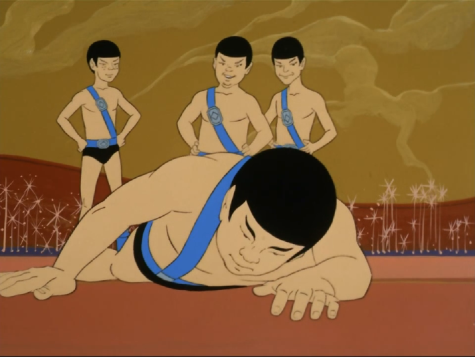
3. It’s mostly written by the same writers.
The animated series features some heavyweight writing talent. David Gerrold, Samuel Peeples, D.C. Fontana, and Paul Schneider all wrote for the original series (and the non-original writers were pretty substantial: Larry Niven even wrote one episode). The series bible is basically the same as that of the original series (and is apparently still in existence, at the Paskow Science Fiction Collection at Samuel Paley Library, Temple University.) The episodes are only 24 minutes long, so the pacing can be a bit hurried, with fewer of the lovely character digressions of the original series, but that also means the scripts are ruthlessly lean and really know how to keep it moving.
And some episodes stand up to anything else in the franchise. “Yesteryear,” where Spock time-travels to the Vulcan of his youth, and meets his mother, father, and younger self, is deeply moving. I dare you to keep a dry eye as Spock returns just in time to watch his beloved childhood pet die. J.J. Abrams paid homage to this episode in his 2009 Star Trek reboot: the scene where young Spock is bullied and belittled by his peers for being bi-racial comes straight out of “Yesteryear.” If you take a chance on only one episode of the animated series, make it this one.
There’s even a tribbles episode! Written by the guy who wrote the original tribbles episode. Even better, the episode is titled “Mo’ Tribbles, Mo’ Troubles” (well, almost), probably the most apt descriptor ever for the tribble lifecycle.
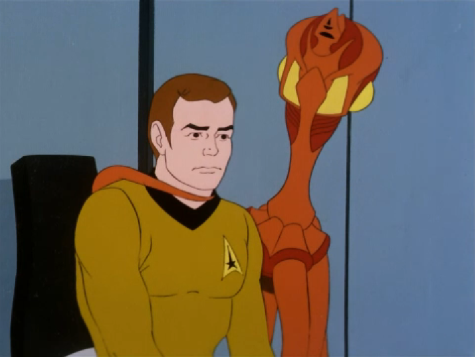
4. It does things the original series could never afford.
In an animated series, the special effects budget is effectively limitless, and TAS totally takes advantage of not being restricted by cheap skin-paint and rubber suit effects to bring you aliens, aliens, aliens. Seriously, not even kidding, there are a lot of weird-looking aliens and creatures in this show, and many of the backgrounds are far beyond anything that could have been built on the original series’ Culver City soundstages.
Like a lot of Filmation series, the animation can look a little low-rent to a modern viewer, but Filmation’s avoidance of the cost of making things “move” is smartly offset by their solid use of voice-overs and sound to camouflage the fact that often nothing’s really happening on screen. The long, slow tracking shot of the Enterprise orbiting a red planet while an impaired, lovesick Scotty croons Welsh ballads (“The Lorelai Signal”) is one of the most sublime moments in the franchise.
Another neat fact about TAS is that it’s the first Trek show to feature the holodeck (here called, in adorable 1970s fashion, the “rec room”). The wondrous room where characters could participate in virtual reality shenanigans was first conceived for the original series, but was deemed unfeasible and far too expensive.
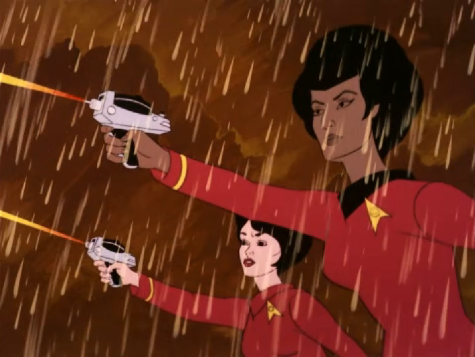
5. It gave secondary characters big moments.
In the original series, most of the episodes revolved entirely around the holy trinity of Kirk, Spock, and McCoy, and while supporting roles like Scotty, Sulu, and Uhura did get some character moments, they were comparatively pretty small. Not so the animated series, which gives the supporting cast more moments to shine.
In “The Lorelai Signal”—the best Uhura story there is—a female medical officer confides in Uhura that the bridge crew have been acting strangely because they’ve been compromised by a mind control signal that only affects the male of the species. Uhura’s response? “Assemble every female security officer on board.” “Why?” “Because I’m taking command of this ship.” And Uhura grabs some phasers and seizes command of the Enterprise, and she takes care of business, and it’s awesome. I mean, right? How could it not be. Hashtag eff yeah Lieutenant Uhura.
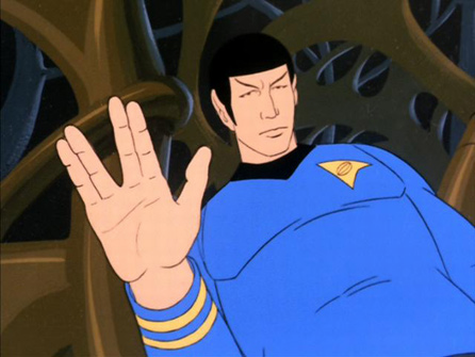
Live long and you know what. And if you’re a fan of the original series, maybe give this one a shot.
David Moran would pay cash money to watch a show or movie about Uhura or Sulu as starship captains, because those short bits in Star Trek VI weren’t enough. Check him out on Twitter or Tumblr.










